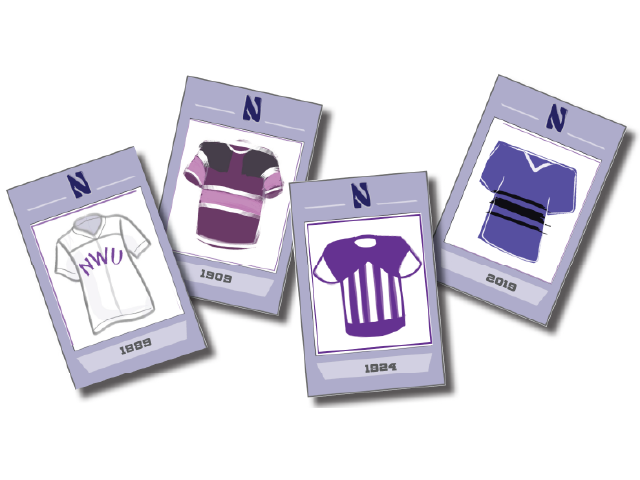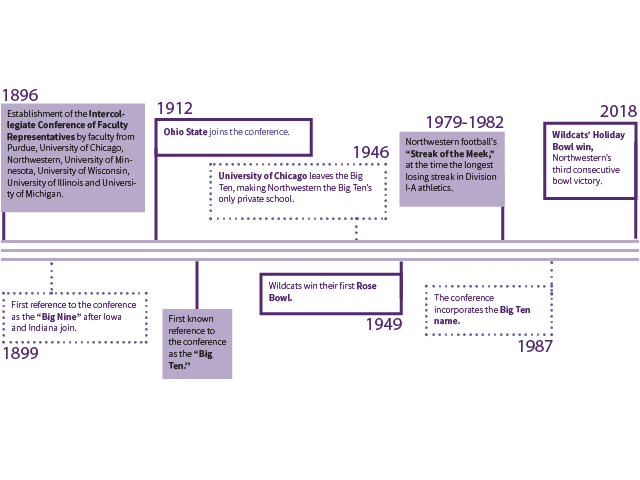Why is Northwestern still Chicago’s Big 10 team?

Northwestern’s membership in the Big Ten is one of its claims to fame among peer institutions, as well as one of its favorite marketing go-to’s.Being “Chicago’s Big Ten Team” is undeniably a source of purple pride.
But why is Northwestern a part of the Big Ten in the first place? Compared to the conference’s other members, all of which are flagship state schools, Northwestern is an outlier. It’s about three times smaller than the next smallest school, the University of Iowa. It is also the only private school and the only school to be ranked in the top 20 of national universities on the U.S. News & World Report.
Athletically, Northwestern has been the historic underdog of the Big Ten, which boasts football giants like Penn State, Ohio State and Michigan. From 1979 to
1982, the Wildcat football team lost 34 games straight, a period dubbed “the streak of the meek.”
While Northwestern differs quite a bit from its fellow Big Ten members, the University is in the prestigious sports conference due to the Big Ten’s
formation more than 100 years ago.
The Big Ten is the oldest D-I athletic conference in the United States — its founding in 1896 predates the NCAA by a decade. The president of Purdue University at the time, James H. Smart, wanted to establish rules to regulate intercollegiate sports. Smart invited other universities in the area to meet and discuss the topic, and representatives from Northwestern and five other Midwestern schools attended.
The members of this meeting became the founding members of one of America’s earliest sports conferences, commonly known as the Western Conference. When Indiana University and the University of Iowa joined in 1899 and Ohio State in
1912, media began to refer to the conference as the “Big Ten.” Known formally as the Intercollegiate Conference Athletics Association, it only officially adopted the Big Ten name after incorporating in 1987.

Long story short, Northwestern joined the Big Ten because of its geographical location and its early interest in intercollegiate sports. In 1946, it became the sole private school after the University of Chicago left the conference, in part because it was no longer competitive with other sports teams, especially in basketball, and chose to prioritize academics over athletics following World War II.
From the beginning, the Big Ten conference has prioritized the “student” half of student-athlete. According to linguistics professor John Gundlach, Northwestern’s faculty athletics representative to the Big Ten, this is what sets it apart from other sports conferences.
“We focus especially on minimizing student athletes’ time away from campus for Big Ten Conference championships and other athletic competitions, and on recognizing student athletes’ academic achievements through conference-level academic honors,” Gundlach says.
Even among the Big Ten, Northwestern is known for its dedication to athletes’ education. In an NCAA report of Graduation Success Rate (GSR) data in October, Northwestern topped all other schools in the Football Bowl Subdivision, the highest level of competition in college football, with a 98 percent GSR.
As Northwestern football player Chris Bergin explains, being a student athlete has been emphasized and gives the University a unique identity: “We call it the four-forty rule: The four years of college versus the 40 years after. I think that sets us apart and gives us such an advantage in the 40 years after, being such a strong academic school but giving us the chance to compete on the biggest stage possible in college sports.”
“We call it the four-forty rule: The four years of college versus the 40 years after"
For Bergin, who grew up in Michigan watching Big Ten football games, Northwestern’s participation in the conference was a critical factor in his decision to choose the school over other options like the Naval Academy, the Air Force Academy and Harvard.
Northwestern’s administration knows its membership in the Big Ten is one of its defining characteristics. Combined with Chicago’s international recognition, the Big Ten name gives Northwestern and its athletic program a discernible identity.
The moniker of “Chicago’s Big Ten Team” helps recruit prospective athletes and enlarge the Wildcats’ fan base according to Paul Kennedy, assistant athletic director for communications at Northwestern.
“It’s more for all the people in the Chicagoland area, especially kids and families that maybe don’t already have an affiliation, to draw them to [Northwestern],” Kennedy says. The campaign has been highly successful: In the years since marketing as “Chicago’s Big Ten Team” took off, football season ticket holders have more than doubled.
Bergin can attest to the power of the Big Ten name as well: “You know when you’re back home or with your friends and you mention the Big Ten, it carries a lot of weight. And so does the name Northwestern, so it’s a double whammy.”